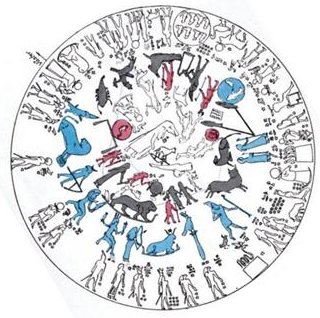The 'overlapping' Libra and Pisces signs are straddling the border lines between summer and winter respectively winter and summer, north of the equator:
Pisces emerges from the midpoint of the staff of a bluemarked figure, and I guess it corresponds to Hatinga Te Kohe - the ruler*s staff is breaking and the two pieces will each generate a 'fish'.
Pisces stands at autumn equinox south of the equator and the blue perching bird on top of a pillar will be at winter solstice. It comes 3 signs later. South of the equator the ecliptic above and the more or less circular paths of the planets appear to move them counterclockwise (as if there was a whirlpool on the surface of the 'water'). North of the equator the planets move with the Sun clockwise, seen from below they move with the Moon counterclockwise. The Sothis cow I have put together with Leo - they are both on board boats. Leo is the 8th of the blackmarked signs (counted from Capricorn and moving clockwise). Moving clockwise from Hatinga Te Kohe (number 12 of the kuhane stations) we will find Sothis as number 16. If we move counterclockwise Sothis will be number 24, which possibly corresponds to Te Pei at kuhane station number 8 (= 24 - 16). If Sothis is assigned number 8, then the perching bird will be number 9, perhaps Te Pou - which would agree with the picture of a pillar. Gemini (the blackmarked twins above) is according to astrology at midsummer (north of the equator). However, precession has moved Gemini (and Canis Major with Sirius) 1 hour forward (and soon Orion will be at midsummer). Astrology is a conservative business and it has frozen its zodical signs. A quarter of the precessional cycle ago Gemini was at spring equinox, and it was The Golden Age. Returning now for a moment to the text of Q and the meaning of pare in *Qa2-40 I think the 2nd glyph line on the front side of the tablet could allude to Aquarius or to Sothis or to Te Pei. They are dark watery signs and 8 * 30 = 240. The bluemarked signs seem to be in summer north of the equator, and therefore in winter south of the equator. But earlier I have put Te Pei at high summer, because I believed there was a continuity from the end of the front side onto the back side. However, that is not necessary. And even if there is a continuity it could be of another sort. I will not easily abandon the results of my earlier efforts and therefore I will continue to believe that Te Pei is at the beginning of the back side not only of the G tablet but also in the calendar of the year. One mysterious and so far unexplained component is why the figures in the Dendera zodiac are not only facing the rising Sun but also appear to describe sequences of events moving counterclockwise (e.g. from Khnum and forward to Satit). Even seen from a position south of the equator the constellations will move in the same direction as the sun. We presumably have to understand this phenomenon before we can connect the text of G (and the rest of the rongorongo texts) with the round zodiac of Dendera. Maybe we then can solve the problem I have created by on one hand suggesting Hatinga Te Kohe to be at Pisces, 3 signs later than winter solstice (the blue perching bird), and on the other hand suggested Roto Iri Are to be below Libra at the lion with his paws on 'water'. Roto Iri Are is the next kuhane station beyond Hatinga Te Kohe, but in the Dendera zodiac the blue lion comes 9 signs later than Pisces. We need a few separate pages in order to discuss if sequences of signs can move against the normal order of time. |
